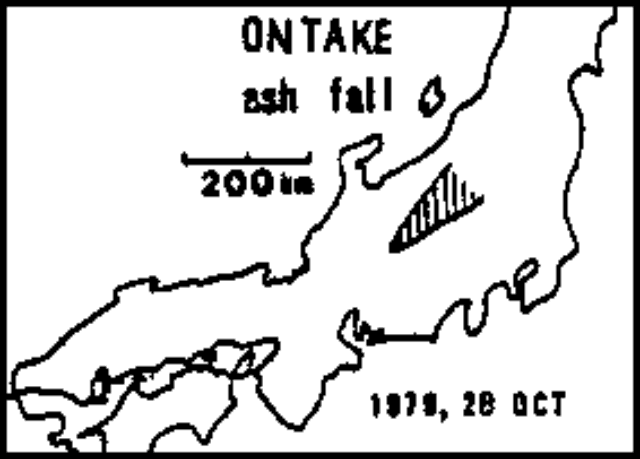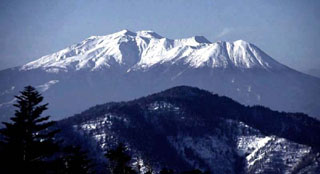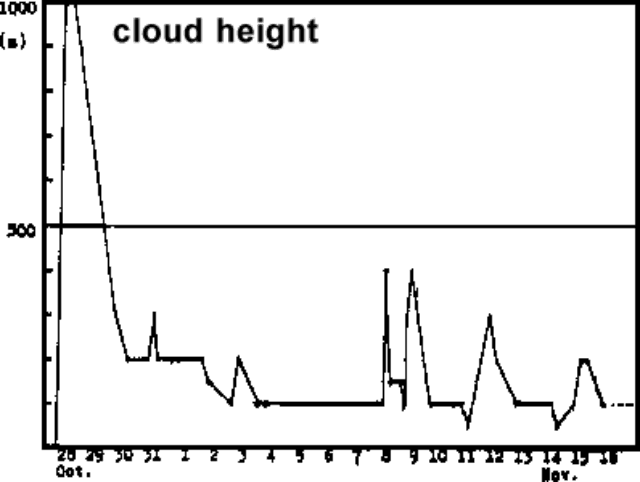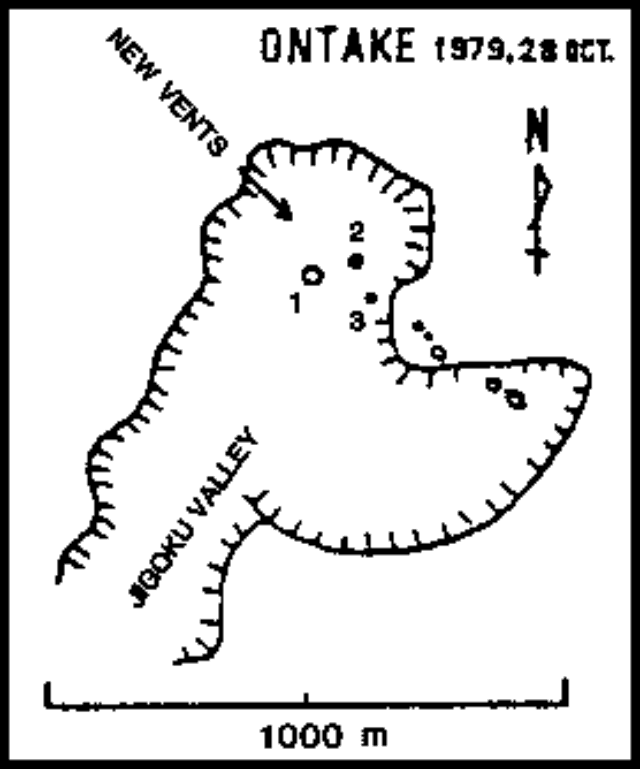Report on Ontakesan (Japan) — November 1979
Scientific Event Alert Network Bulletin, vol. 4, no. 11 (November 1979)
Managing Editor: David Squires.
Ontakesan (Japan) More information on 28 October eruption
Please cite this report as:
Global Volcanism Program, 1979. Report on Ontakesan (Japan) (Squires, D., ed.). Scientific Event Alert Network Bulletin, 4:11. Smithsonian Institution. https://doi.org/10.5479/si.GVP.SEAN197911-283040
Ontakesan
Japan
35.893°N, 137.48°E; summit elev. 3067 m
All times are local (unless otherwise noted)
On-take's first eruption in historic time began suddenly before dawn on 28 October. No initial explosion was heard and no shock wave was recorded by JMA seismic stations, [but long-duration tremor was recorded from 0520 that may have been eruption tremor]. Ash emission continued through the day, intermittently during the morning but continuously during the afternoon, with strongest activity at about 1400. A dark ash cloud rose about 1 km (figure 2). About 1.5 m of ash fell near the summit and a few tens of centimeters fell on the flank. [A few millimeters] were deposited on [the villages of] Kaida-mura (12 km NE) and Mitake-mura (14 km SE), [the nearest inhabited areas] and slight ashfall covered a wide area as far as 150 km NE of the volcano (figure 3). No ejections of incandescent blocks were seen, but aerial observers reported that blocks were scattered around the vents (see below). Activity declined to white vapor emission before dawn on 29 October, although a slight ashfall occurred at a nearby village that morning. Steaming continued at varying intensity through mid-November.
 |
Figure 3. Sketch map of S Honshu and Shikoku Islands, Japan. Area of ashfall from On-take is shaded. Courtesy of JMA. |
During the eruption, numerous vents were active in a 500 m-long NW-SE-trending zone near the summit (figures 1 and 4). Along some portions of the zone, curtains of steam were visible from the air on 28 October. Kazuaki Nakamura reported that 10 small craters were seen during an aerial inspection on 3 November; four craters were emitting vapor. Takeshi Kobayashi, who has studied the volcano for 20 years, reported that no fumaroles existed prior to the eruption in the new vent zone.
No historical eruptions are known from On-take, one of Japan's larger stratovolcanoes. Kobayashi reports that the youngest 14C dates from On-take, 23,000 BP, are from scoria and lava flows composed of two-pyroxene andesite, ejected from at least five craters forming a NNE-SSW line on the N flank.
Further References. Aoki, H., 1980, A compilation of reports on the volcanic activity and hazards of the 1979 eruption of On-take volcano: Special publication by the research group for the 1979 On-take eruption, no. B-54-3, 168 p.
Aramaki, S., and Ossaka, J., 1983, Eruption of On-takesan, October 28, 1979, in XVIII IUGG General Assembly, Hamburg, Report on volcano activities and studies in Japan for the period from 1979 to 1982, p. 1-7.
Geological Summary. The massive Ontakesan stratovolcano, the second highest volcano in Japan, lies at the southern end of the Northern Japan Alps. Ascending this volcano is one of the major objects of religious pilgrimage in central Japan. It is constructed within a largely buried 4 x 5 km caldera and occupies the southern end of the Norikura volcanic zone, which extends northward to Yakedake volcano. The older volcanic complex consisted of at least four major stratovolcanoes constructed from about 680,000 to about 420,000 years ago, after which Ontakesan was inactive for more than 300,000 years. The broad, elongated summit of the younger edifice is cut by a series of small explosion craters along a NNE-trending line. Several phreatic eruptions post-date the roughly 7300-year-old Akahoya tephra from Kikai caldera. The first historical eruption took place in 1979 from fissures near the summit. A non-eruptive landslide in 1984 produced a debris avalanche and lahar that swept down valleys south and east of the volcano. Very minor phreatic activity caused a dusting of ash near the summit in 1991 and 2007. A significant phreatic explosion in September 2014, when a large number of hikers were at or near the summit, resulted in many fatalities.
Information Contacts: JMA, Tokyo; JMA also forwarded information fromT. Kobayashi (Toyama Univ.); K. Nakamura, ERI, Univ. of Tokyo.



